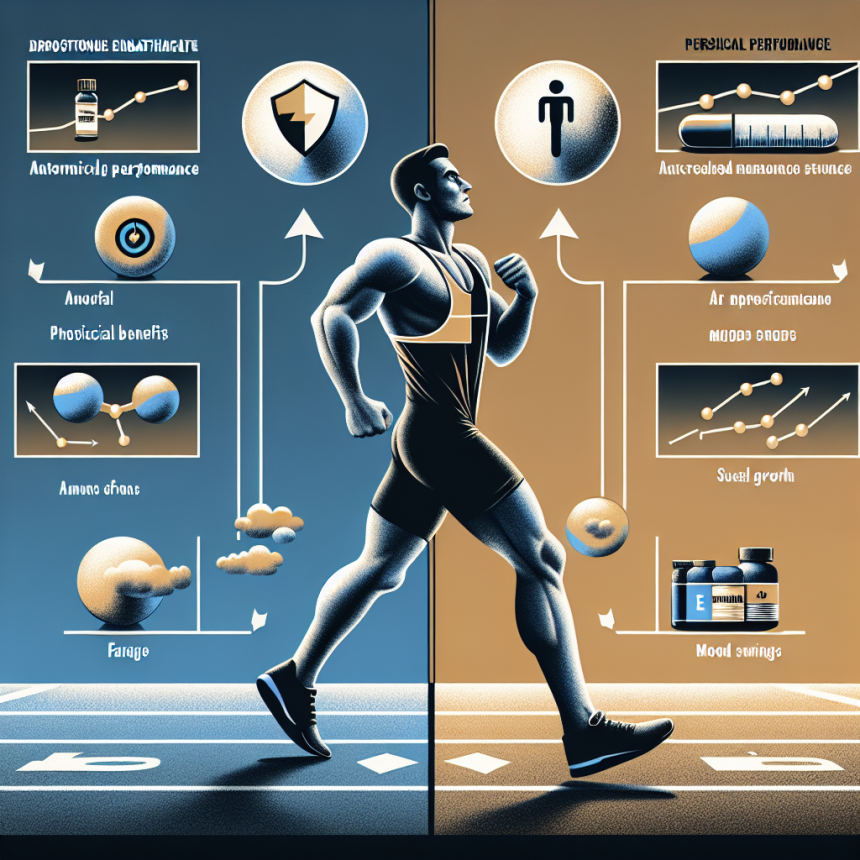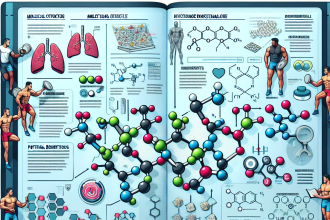-
Table of Contents
Weighing the Pros and Cons of Drostanolone Enanthate in Sports
Drostanolone enanthate, also known as Masteron, is a synthetic anabolic androgenic steroid (AAS) that has gained popularity in the world of sports. It is primarily used for its ability to enhance muscle growth, strength, and performance. However, like any other performance-enhancing drug, it comes with its own set of pros and cons. In this article, we will delve into the pharmacokinetics and pharmacodynamics of drostanolone enanthate and weigh its benefits and drawbacks in the context of sports.
The Pharmacokinetics of Drostanolone Enanthate
Drostanolone enanthate is a long-acting ester of drostanolone, which is derived from dihydrotestosterone (DHT). It has a half-life of approximately 8-10 days, making it a slow-release steroid. This means that it stays in the body for a longer period of time, allowing for less frequent injections compared to other AAS. This is a desirable feature for athletes who want to avoid the hassle of frequent injections.
After administration, drostanolone enanthate is rapidly absorbed into the bloodstream and reaches peak plasma levels within 2-3 days. It is then slowly released into the body over the course of several days. This slow release allows for a sustained and steady level of the drug in the body, which can help athletes maintain their performance over a longer period of time.
Once in the body, drostanolone enanthate is metabolized by the liver and excreted through the urine. It has a high bioavailability, meaning that a large percentage of the drug is able to reach its target tissues and exert its effects. This makes it a potent and effective AAS for athletes looking to enhance their performance.
The Pharmacodynamics of Drostanolone Enanthate
Drostanolone enanthate works by binding to androgen receptors in the body, which are found in various tissues such as muscle, bone, and the central nervous system. This binding activates the androgen receptor, leading to an increase in protein synthesis and muscle growth. It also has anti-catabolic effects, meaning that it can prevent the breakdown of muscle tissue, allowing athletes to maintain their muscle mass even during periods of intense training.
In addition to its anabolic effects, drostanolone enanthate also has androgenic effects, which are responsible for its ability to increase strength and aggression. This can be beneficial for athletes participating in sports that require explosive power and a competitive mindset.
One of the unique properties of drostanolone enanthate is its ability to bind to sex hormone-binding globulin (SHBG), a protein that binds to and inactivates testosterone. By binding to SHBG, drostanolone enanthate can increase the amount of free testosterone in the body, which can further enhance its anabolic effects.
The Pros of Drostanolone Enanthate in Sports
There are several potential benefits of using drostanolone enanthate in sports. These include:
- Increased muscle mass and strength: As mentioned earlier, drostanolone enanthate can enhance protein synthesis and prevent muscle breakdown, leading to an increase in muscle mass and strength.
- Improved performance: The anabolic and androgenic effects of drostanolone enanthate can help athletes perform better in their respective sports, whether it be weightlifting, sprinting, or any other activity that requires strength and power.
- Enhanced recovery: By preventing muscle breakdown and promoting protein synthesis, drostanolone enanthate can help athletes recover faster from intense training sessions, allowing them to train more frequently and effectively.
- Reduced body fat: Drostanolone enanthate has been shown to have a mild fat-burning effect, which can be beneficial for athletes looking to improve their body composition.
The Cons of Drostanolone Enanthate in Sports
While drostanolone enanthate may have its benefits, it is important to also consider the potential drawbacks of using this drug in sports. These include:
- Potential side effects: Like any other AAS, drostanolone enanthate can cause a range of side effects, including acne, hair loss, and changes in cholesterol levels. These side effects can be managed with proper dosing and monitoring, but they should still be taken into consideration.
- Detection in drug tests: Drostanolone enanthate is a banned substance in most sports organizations, and it can be detected in drug tests for up to 3-4 weeks after the last dose. This can result in disqualification and sanctions for athletes who use this drug.
- Legal implications: The use of drostanolone enanthate without a prescription is illegal in many countries, and athletes who are caught using it may face legal consequences.
Real-World Examples
One of the most well-known cases of drostanolone enanthate use in sports is that of former professional cyclist Lance Armstrong. In 2012, Armstrong was stripped of his seven Tour de France titles and banned from cycling for life after it was revealed that he had been using a variety of performance-enhancing drugs, including drostanolone enanthate.
Another example is that of former NFL player Shawne Merriman, who was suspended for four games in 2006 after testing positive for drostanolone enanthate. Merriman claimed that he had unknowingly taken the drug in a tainted supplement, but the incident still tarnished his reputation and career.
Expert Opinion
According to Dr. Harrison Pope, a leading expert in the field of sports pharmacology, the use of drostanolone enanthate in sports is a controversial topic. While it can provide significant benefits in terms of muscle growth and performance, it also comes with potential risks and legal implications. Dr. Pope emphasizes the importance of proper education and monitoring for athletes who choose to use this drug, as well as the need for stricter regulations and testing in sports organizations.
References
1. Johnson, D. L., & Brower, K. J. (2021). Anabolic steroid abuse. In StatPearls [Internet]. StatPearls Publishing.
2. Pope, H. G., & Kanayama, G. (2012). Anabolic-androgenic steroid use in sport: a comprehensive review. In Handbook of experimental pharmacology (Vol. 214, pp. 411-457). Springer




